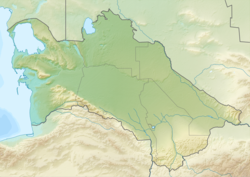| Danata Formation | |
|---|---|
|
Stratigraphic range:
Early Eocene-Mid Eocene ~ | |
| Type | Geological formation |
| Location | |
| Coordinates | 38°38′N 55°48′E / 38.633°N 55.800°E [1] |
| Approximate paleocoordinates | 35°06′N 51°12′E / 35.1°N 51.2°E |
| Country | |
The Danata Formation (or Danatinskaya, Danatinsk, Russian: Danata Svita) is an earliest Eocene to Middle Eocene sedimentary succession located in Turkmenistan. It is mostly famous for its fish-bearing horizons ( Ichthyofauna). [1] The formation for example crops out in the Kopet Dag mountain range in the border region of Turkmenistan and Iran. [1]
Previously, it was thought that the earliest horizons of this formation dated to the latest Paleocene ( Thanetian). However, more recent studies have found the formation's sapropel to originate from a global anoxic event caused by the Paleocene-Eocene Thermal Maximum, indicating that it formed just after the Paleocene-Eocene boundary, during the earliest Ypresian. [2]
Fossil content
The Danata Formation is famous for its ichthyofauna. The fish are found in a 9 metres (30 ft) thick clay horizon in the middle of the succession, that has been dated as Upper Paleocene. [1] This includes fossils of the family Turkmenidae. Luvarus necopinatus was first described in this formation. Other fossils of fish include the genera Eospinus, Danatinia, Exellia, Turkmene and Avitoluvarus. The snake species Archaeophis turkmenicus has also been described. [3]
A similar fauna occurs in the Moler Formation in Denmark. [1]
References
- ^ a b c d e Prokofiev, Artém M. "The Late Paleocene fish fauna of Turkmenistan" (PDF). Archived from the original (PDF) on 15 March 2016. Retrieved 15 November 2013.
- ^ Bannikov, A. F.; Erebakan, I. G. (2023-10-01). "On the Evolution of Some Groups of Marine Bony Fishes in the Cenozoic of the Tethys and Paratethys". Paleontological Journal. 57 (5): 475–490. Bibcode: 2023PalJ...57..475B. doi: 10.1134/S0031030123050015. ISSN 1555-6174.
- ^ Head et al., 2005
Bibliography
- Head, Jason J.; Holroyd, Patricia A.; Hutchison, J. Howard; Ciochon, Russell L. (2005), "First report of snakes (Serpentes) from the Late Middle Eocene Pondaung Formation, Myanmar", Journal of Vertebrate Paleontology, 25 (1): 246–250, doi: 10.1671/0272-4634(2005)025[0246:FROSSF]2.0.CO;2
| Danata Formation | |
|---|---|
|
Stratigraphic range:
Early Eocene-Mid Eocene ~ | |
| Type | Geological formation |
| Location | |
| Coordinates | 38°38′N 55°48′E / 38.633°N 55.800°E [1] |
| Approximate paleocoordinates | 35°06′N 51°12′E / 35.1°N 51.2°E |
| Country | |
The Danata Formation (or Danatinskaya, Danatinsk, Russian: Danata Svita) is an earliest Eocene to Middle Eocene sedimentary succession located in Turkmenistan. It is mostly famous for its fish-bearing horizons ( Ichthyofauna). [1] The formation for example crops out in the Kopet Dag mountain range in the border region of Turkmenistan and Iran. [1]
Previously, it was thought that the earliest horizons of this formation dated to the latest Paleocene ( Thanetian). However, more recent studies have found the formation's sapropel to originate from a global anoxic event caused by the Paleocene-Eocene Thermal Maximum, indicating that it formed just after the Paleocene-Eocene boundary, during the earliest Ypresian. [2]
Fossil content
The Danata Formation is famous for its ichthyofauna. The fish are found in a 9 metres (30 ft) thick clay horizon in the middle of the succession, that has been dated as Upper Paleocene. [1] This includes fossils of the family Turkmenidae. Luvarus necopinatus was first described in this formation. Other fossils of fish include the genera Eospinus, Danatinia, Exellia, Turkmene and Avitoluvarus. The snake species Archaeophis turkmenicus has also been described. [3]
A similar fauna occurs in the Moler Formation in Denmark. [1]
References
- ^ a b c d e Prokofiev, Artém M. "The Late Paleocene fish fauna of Turkmenistan" (PDF). Archived from the original (PDF) on 15 March 2016. Retrieved 15 November 2013.
- ^ Bannikov, A. F.; Erebakan, I. G. (2023-10-01). "On the Evolution of Some Groups of Marine Bony Fishes in the Cenozoic of the Tethys and Paratethys". Paleontological Journal. 57 (5): 475–490. Bibcode: 2023PalJ...57..475B. doi: 10.1134/S0031030123050015. ISSN 1555-6174.
- ^ Head et al., 2005
Bibliography
- Head, Jason J.; Holroyd, Patricia A.; Hutchison, J. Howard; Ciochon, Russell L. (2005), "First report of snakes (Serpentes) from the Late Middle Eocene Pondaung Formation, Myanmar", Journal of Vertebrate Paleontology, 25 (1): 246–250, doi: 10.1671/0272-4634(2005)025[0246:FROSSF]2.0.CO;2
